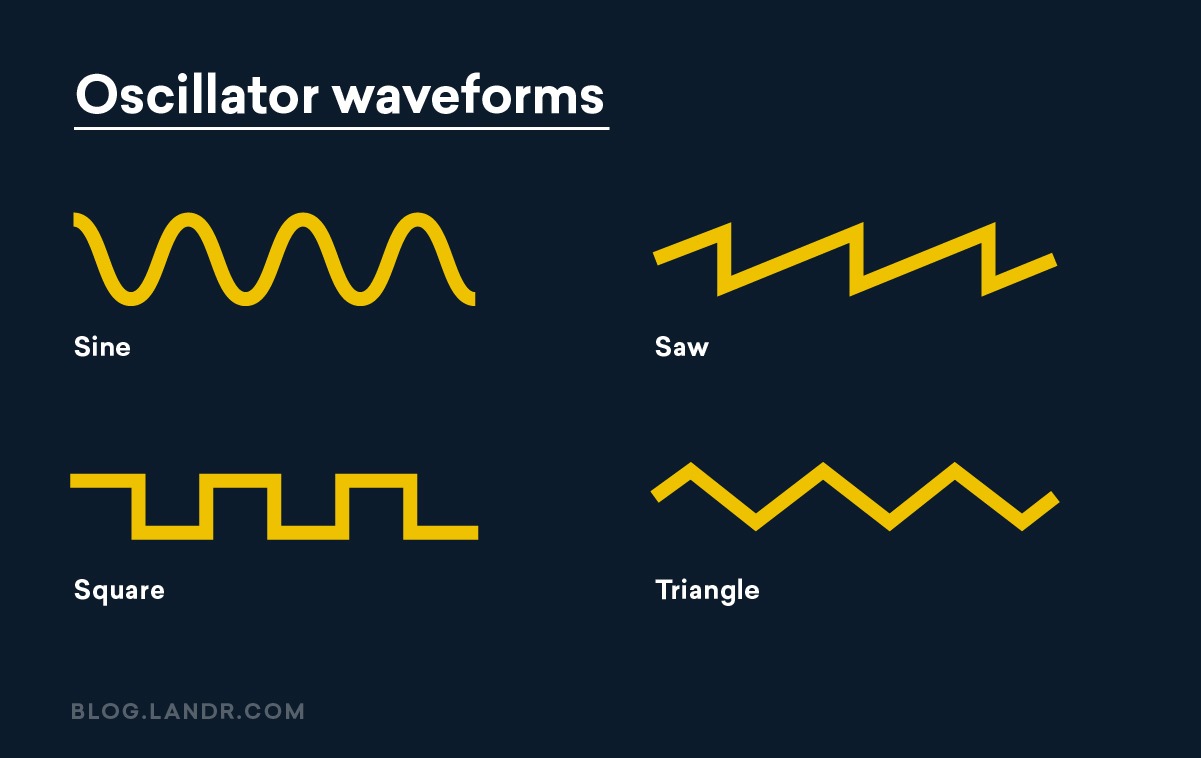Synth pads are the washy ambient textures that help build the atmosphere of a track.
You may not hear them clearly in a dense mix, but pads often provide the sonic backdrop that glues a song together.
Creating great synth pads isn’t easy if you’ve never tried them before. With so many parameters to keep track of, many synth plugins make it difficult to program the right sound.
Even so, beginners can get started with ambient synth textures with just a few key techniques.
In this article I’ll explain how to build huge atmospheric synth pads in 5 steps.
Let’s get started.
1. Build a rich waveform to start with
In subtractive synthesis you start with a wave that’s rich in harmonics and narrow it down with filters and envelopes.
That’s why it’s important to choose the right type of waveform you use in your patch.
If you start with a rich waveform like a square or sawtooth wave you’ll have plenty of harmonics to experiment with as you build your sound.

As you build your patch you can always use the low-pass filter to smooth out the higher frequencies for a warmer sound.
Most synths have multiple oscillators you can blend together. That means you get to experiment with mixing different waveforms and octave positions together for an even more complex starting point.
Try to strike a balance between richness, movement and harmonics with your basic waveform.
If you start with a rich waveform like a square or sawtooth wave you’ll have plenty of harmonics to experiment with as you build your sound.
2. Adjust the envelope to make the overall shape of the sound
The amplitude envelope is where you create the basic qualities that turn an ordinary synth tone into a pad sound.
In most subtractive synths the amplifier section is linked by default to an envelope generator that you adjust using ADSR controls.
ADSR stands for Attack, Decay, Sustain and Release. If you need a refresher on how these work, head over to our in-depth guide to brush up.

Pad sounds use specific ADSR settings that give them their atmospheric quality.
Pad sounds use specific ADSR settings that give them their atmospheric quality.
The first is a long attack time that rises slowly so that the sound gradually fades in. The second is a long release time so that sound slowly decays when you release the keys.
In a polyphonic synth that means that each chord fades into the next as you play, creating an evolving ambience that sits nicely in the background.
These two ADSR settings are the basis of a good pad tone, but the exact values are up to you.
Try to set your attack and release so that they rise and fall in time with the music.
The decay time and sustain level also contribute to a nice pad, so don’t forget to dial those in a well.
With the right envelope shape you’re well on your way to designing the perfect pad.
3. Use your low pass filter to sculpt the frequencies
Even with a nice gradual envelope, a rich waveform can sound pretty harsh with the filter wide open.
The next step to building your pad sound is to use your synth’s low pass filter to to shape the frequency balance.
The low pass filter’s cutoff frequency decides how much high end your pad will contain. Bring it down to create a warmer sound.
The resonance control lets you add emphasis right around the cutoff frequency. At high resonance settings, frequencies in this area will be boosted, creating a distinctive peak.

Use your synth’s filters to sculpt the frequencies so that the pad sits comfortably in the background of your track.
The low pass filter’s cutoff frequency decides how much high end your pad will contain. Bring it down to create a warmer sound.
4. Use LFOs to create modulation
If you’ve been following along so far you’ve made a nice warm synth pad with a satisfying envelope.
But without modulation it’s probably a bit boring. Modulation is how you create movement and interest in a synth patch.
Imagine you had a third hand that could turn the knobs back and forth at a regular rate—that’s how LFOs work!
They’re a separate waveform that oscillates at a much lower frequency than the audio oscillators that create the synth’s basic waves.
You can assign the LFO to any parameter you’d like to animate in your synth patch.
There’s so much creative potential with modulation, but here are a few LFO destinations that create well-known synth effects:

Use your LFOs and modulation matrix to add intrigue, action and development to your synth pads.
5. Add effects for extra ambience
Pads and audio effects like delay and reverb are made for each other.
Pads and audio effects like delay and reverb are made for each other.
Even if you’ve built a great atmospheric sound using just your synthesizer’s built-in functions, delay and reverb can give your synth pad an even deeper and more satisfying texture.
On top of that, time-based effects often feature LFO modulation of their own. This will create light pitch modulation in the reverb tails or delay repeats that adds dimension to the sound.
Atmospheric synth sounds
Pads are one of the most important types of synth patches. Every producer should at least understand the basics of how to build them.
If you’ve made it through this tutorial you’ll have a great start for how to create pad sounds from scratch on your synths or plugins.
